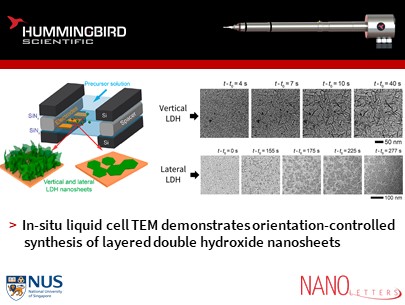Layered double hydroxides (LDHs) are two-dimensional (2D) materials studied for future catalytic applications. Understanding the mechanism of LDHs growth is key to determining their electrocatalytic properties. The National University of Singapore (NUS) researchers have demonstrated using Hummingbird Scientific’s in-situ TEM liquid cell electrochemistry holder that there are at least two growth modes of LDHs layered nanosheets. Depending on the concentration of the precursor solution, the LDHs nanosheets can be grown either in the vertical or parallel to a substrate. The work has been recently published in Nano Letters.

The vertical LDH nanosheets are grown in-situ using an aqueous solution containing 150 mM Co(NO3)2 and 150 mM FeSO4. The working electrode (Pt) is biased at -0.6V. Similarly, the lateral LDH nanosheets are grown in-situ when the concentration of the precursor solution is lowered, containing 15 mM Co(NO3)2 and 15 mM FeSO4. The fundamental insight into the growth mechanism observed in-situ can help tailor LDH properties and opens new researches into a wide range of catalytic relevant materials.
Reference: Wenhui Wang, See Wee Chee, Hongwei Yan, Ivan Erofeev, and Utkur Mirsaidov. “Growth Dynamics of Vertical and Lateral Layered Double Hydroxide Nanosheets during Electrodeposition,” Nano Letters (2021). Full Paper
View All News

